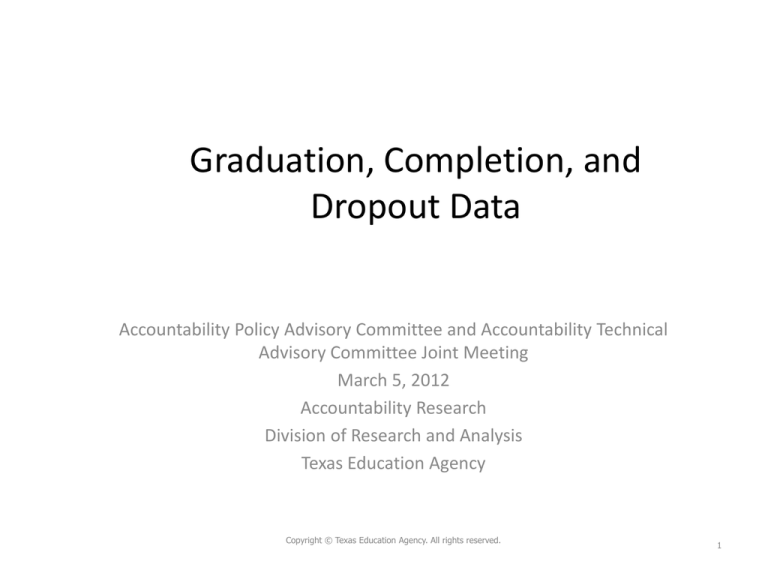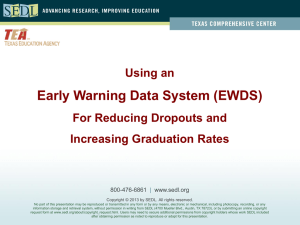
Graduation, Completion, and
Dropout Data
Accountability Policy Advisory Committee and Accountability Technical
Advisory Committee Joint Meeting
March 5, 2012
Accountability Research
Division of Research and Analysis
Texas Education Agency
Copyright © Texas Education Agency. All rights reserved.
1
Table of Contents
• Statutory requirements for leaver
indicators in state accountability
• Dropout definition
• Annual dropout rates
• Longitudinal rates
Copyright © Texas Education Agency. All rights reserved.
2
Statutory requirements for leaver indicators
in state accountability
TEC 39.053(c)
(2) dropout rates, including dropout rates and district
completion rates for grade levels 9 through 12, computed in
accordance with standards and definitions adopted by the
National Center for Education Statistics of the United States
Department of Education; and
(3) high school graduation rates, computed in accordance with
standards and definitions adopted in compliance with the
No Child Left Behind Act of 2001 (20 U.S.C. Section 6301 et
seq.).
Copyright © Texas Education Agency. All rights reserved.
3
Exclusions required by TEC 39.053(g-1)
House Bill (HB) 3, 81st Legislative Session, defined certain exclusions
that the agency must make when calculating dropout and completion
rates for state performance ratings. The exclusions are:
–
–
–
–
Students previously reported as dropouts;
Students not eligible for state funding;
Students court-ordered to GED programs, GEDs not earned;
Students incarcerated as adults in state jails or federal
penitentiaries;
– Students whose initial enrollment in U.S. schools was in grades
7-12 as unschooled refugees and asylees; and
– Students detained in county detention facilities.
Copyright © Texas Education Agency. All rights reserved.
4
Dropout definition
A dropout is a student who attends Grade 7-12 in a public school in a
particular school year, does not return the following fall, is not expelled,
and does not:
•
•
•
•
•
graduate,
receive a General Educational Development certificate (GED),
continue school outside the public school system,
begin college, or
die.
Note. SB186, 78th Legislature, directed districts to collect data consistent with the National Center for
Education Statistics (NCES) dropout definition beginning in 2005-06. The 2010-11 school year was the
sixth year the definition was in effect.
Copyright © Texas Education Agency. All rights reserved.
5
Annual dropout rates
• Definition: The percentage of students who drop out of school
during one school year.
• Can be calculated by grade level and by grade span. For example,
grades 7-8, grades 9-12, and grades 7-12.
• Calculation:
number of students who dropped out during the school year
number of students enrolled during the school year
Copyright © Texas Education Agency. All rights reserved.
6
Longitudinal rates
Completion rate
• A completion rate is the percentage of students from a class of
beginning ninth graders who complete their high school education
by the anticipated graduation date. The cohort includes students
who transfer into Texas public schools during the second, third, and
fourth years.
• A completer may be defined as a student who graduates, continues
high school in the fall after expected graduation, or receives a GED.
Graduation rate
• A graduation rate is the percentage of students from the same class
who graduate by the anticipated graduation date.
Copyright © Texas Education Agency. All rights reserved.
7
Longitudinal rate calculations
Completion I rate
graduates + continuers
graduates + continuers + GED recipients + dropouts
Completion II rate
graduates + continuers + GED recipients
graduates + continuers + GED recipients + dropouts
Copyright © Texas Education Agency. All rights reserved.
8
Longitudinal rate calculations (continued)
Graduation rate
graduates
graduates + continuers + GED recipients + dropouts
Longitudinal dropout rate
dropouts
graduates + continuers + GED recipients + dropouts
Copyright © Texas Education Agency. All rights reserved.
9
Longitudinal completion rate calculations (continued)
• Four-year rates: Based on tracking of students for four
years and into the fall of the fifth year. In 2012, TEA will
calculate four-year completion rates for the class of 2011.
These are rates for students who began ninth grade in
2007-08.
• Five-year rates: Based on tracking of students for five
years and into the fall of the sixth year. In 2012, TEA will
calculate five-year completion rates for the class of 2010.
These are rates for students who began ninth grade in
2006-07.
Copyright © Texas Education Agency. All rights reserved.
10
Uses of longitudinal rates for federal accountability
• The graduation rate is used for federal accountability.
• Four-year and five-year graduation rates have been
approved by U.S.D.E. for use in federal adequate yearly
progress evaluations.
• Definition: The graduation rate calculated for federal
accountability follows federal guidelines. The exclusions
from rates calculated for state accountability required by
House Bill 3 (TEC 39.053(g-1)) do not apply to rates
calculated for federal accountability (AYP).
Copyright © Texas Education Agency. All rights reserved.
11
Exclusions required by TEC 39.053(g-1)
• HB 3 required use of the NCES dropout definition until 201112. The 2011-12 effective date means students who attend in
2010-11 and 2010-11 leavers submitted by districts in the
2011-12 year.
• The 2010-11 annual dropout rates and the class of 2011
longitudinal rates are the first rates affected by this statute.
• No longer alignment between rates calculated for the state
and federal accountability systems.
Copyright © Texas Education Agency. All rights reserved.
12









